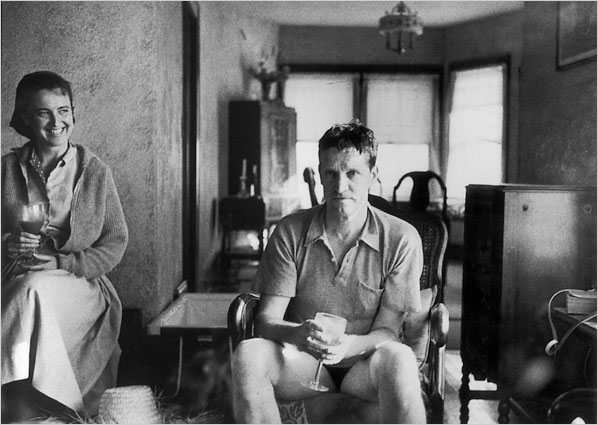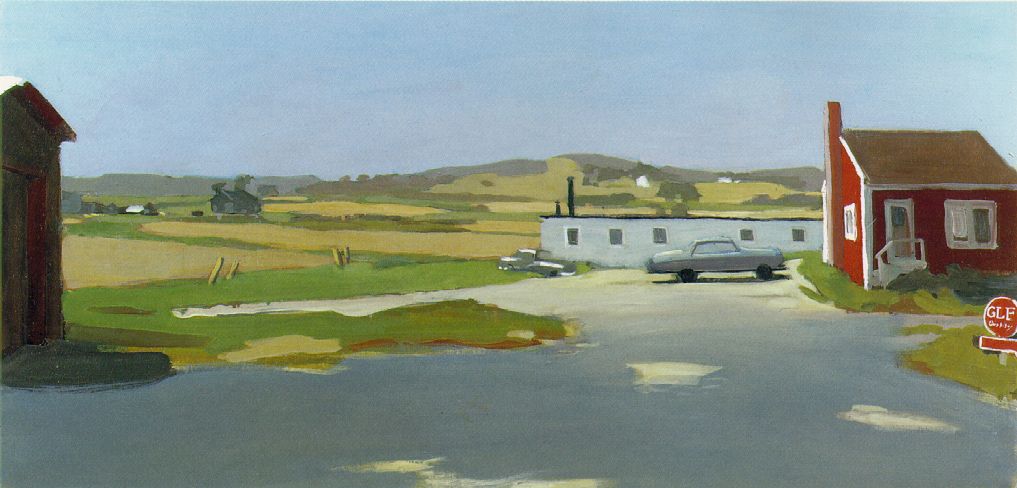
Respect for Things As They Are
by JOHN ASHBERY
In his introduction to Fairfield Porter's posthumous collection of art criticism, Art in Its Own Terms, Rackstraw Downes quotes a remark Fairfield Porter made during what must have been one of the more Byzantine discussions at the Artists' Club on Eighth Street, around 1952. The members were arguing about whether or not it was vain to sign your paintings. With the flustered lucidity of Alice in the courtroom, Porter sliced this particular Gordian knot once and for all: "If you are vain it is vain to sign your pictures and vain not to sign them. If you are not vain it is not vain to sign them and not vain not to sign them."
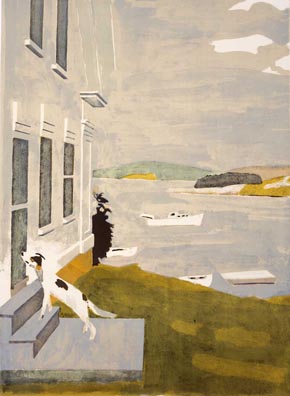 We do not know the reaction of his colleagues; quite possibly this mise au net fell on the same deaf ears that ignored the urgent but plain and unpalatable truths that Porter voiced again and again in his writings on art, at a time of particularly hysterical factionalism. No one likes to be reminded of the obvious, when half-truths are so much richer and more provocative; thus it was Porter's fate both as critic and as painter to play the role of a Moliere gadfly, an Alceste or a Clitandre in a society of stentorian precieuses ridicules. And to a certain extent, his reputation as an eccentric remains, though it stemmed from a single-minded determination to speak the truth. Handsome is as handsome does; actions speak louder than words: who, in the course of the Artists' Club's tumultuous sessions, could pause to listen to such drivel?
We do not know the reaction of his colleagues; quite possibly this mise au net fell on the same deaf ears that ignored the urgent but plain and unpalatable truths that Porter voiced again and again in his writings on art, at a time of particularly hysterical factionalism. No one likes to be reminded of the obvious, when half-truths are so much richer and more provocative; thus it was Porter's fate both as critic and as painter to play the role of a Moliere gadfly, an Alceste or a Clitandre in a society of stentorian precieuses ridicules. And to a certain extent, his reputation as an eccentric remains, though it stemmed from a single-minded determination to speak the truth. Handsome is as handsome does; actions speak louder than words: who, in the course of the Artists' Club's tumultuous sessions, could pause to listen to such drivel?
I hadn't known this statement of Porter's before reading Downes's preface, but somehow it caused all my memories of the man I knew well for more than twenty years (without, alas, pausing very often to look or listen well) to fall into place. Porter was, of course, only the latest of a series of brilliant know-nothings who at intervals have embodied the American genius, from Emerson and Thoreau to Whitman and Dickinson down to Wallace Stevens and Marianne Moore.
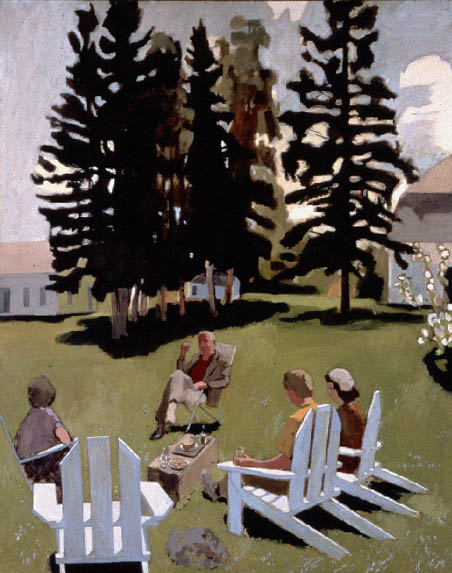 Her title "In Distrust of Merits" could stand for all of them and her preference for winter over summer reminds me of Porter's saying in a letter to a friend: "November after the leaves have fallen may be one of the best times of year on Long Island. That is, I like the way the trees don't block the light any more. " And I realized after such a long acquaintanceship that his paintings, which most people like but have difficulty talking about (Are they modern enough? Too French? Too pleasant? Hasn't this been done before?), are part of the intellectual fabric that underlay his opinions, his conversation, his poetry, his way of being. They are intellectual in the classic American tradition of the writers mentioned above because they have no ideas in them, that is, no ideas that can be separated from the rest.
Her title "In Distrust of Merits" could stand for all of them and her preference for winter over summer reminds me of Porter's saying in a letter to a friend: "November after the leaves have fallen may be one of the best times of year on Long Island. That is, I like the way the trees don't block the light any more. " And I realized after such a long acquaintanceship that his paintings, which most people like but have difficulty talking about (Are they modern enough? Too French? Too pleasant? Hasn't this been done before?), are part of the intellectual fabric that underlay his opinions, his conversation, his poetry, his way of being. They are intellectual in the classic American tradition of the writers mentioned above because they have no ideas in them, that is, no ideas that can be separated from the rest.
They are idea, or consciousness, or light, or whatever. Ideas surround them, but do not and cannot extrude themselves into the being of the art, just as the wilderness surrounds Stevens's jar in Tennessee: an artifact, yet paradocixally more natural th than the "slovenly" wilderness that approaches it, and from which it takes "dominion."
Porter wrote of de Kooning: "His meaning is not that the paintings have Meaning.... The vacuum they leave behind them is a vacuum in accomplishment, in significance, and in genuineness," and, as so often, the critic's words apply to his own art as well.
Porter had a horror of "art as sociology," of the artist who "treates art as though it were raw material for a factory that produces a commodity called understanding. For art and that commodity are one, and art that illustrates an idea, however remotely or tangentially, has forfeited its claim to be considered art by introducing a fatal diviseness into what can only be whole. "I can't be distracted from paying the closest possible attention to what I am doing by evaluating it ahead of time," he wrote in a letter to the critic Claire Nicolas White.
"What one pays attention to is what is real (I mean reality calls for one's attention) and reality is everything. It is not only the best part. It is not an essence. Everything includes the pigment as much as the canvas as much as the subject." Although Porter's work is in some ways the product of an idea - the idea that ideas have no place in art, or at any rate that they have no separate life of their own in art, no autonomy that might siphon off part of the "reality" of the ensemble - it is in accord, appearances to the contrary, with the seemingly more "advanced" work of the contemporaries he admired: de Kooning, Johns, Lichtenstein, Brice Marden, the music of Cage and Feldman - artists whose work at first seems worlds apart from the backyards and breakfast tables that were Porter's subjects but were only a part of "everything."
Even today there are admirers of Porter's paintings who are bemused by his apparently wayward tastes in art, just as there are those who can't understand how Cage and Virgil Thomson can see anything in each other's music, forgetting how art submerges categories.
"You can only buck generalities by attention to fact," Porter continued. "So aesthetics is what connects one to matters of fact. It is anti-ideal, it is materialistic. It implies no approval, but respect for things as they are." This last point seems hardest to digest for artists who believe that art is "raw material for a factory that produces a commodity called understanding." Thus, politically "concerned" artists continue to make pictures that illustrate the horrors of war, of man's inhumanity to man; feminist artsts produce art in which woman is exalted, and imagine that they have accomplished a useful act; and no doubt there are a number of spectators who find it helpful to be reminded that there is room for improvement in the existing order of things. Yet beyond the narrow confines of the "subject" (one one of a number of equally important elements in the work of art, as Porter points out) the secret business of art gets done according to mysterious rules of its own. In this larger context ideology simply doesn't function as it is supposed to, when indeed it isn't directly threatening the work of art by trivializing it, and trivializing as well the importance of the ideas it seeks to dramatize.
For Porter, the enemy was "idealism," which was very close to something called "technology." As a citizen he was preoccupied - almost obsessed, in fact - with questions of ecology and politics, and politics of a most peculiar sort; he had been something of a Marxist in the thirties but in later life his political pronouncements could veer from far left to extreme right without any apparent transition. And in conversation he could become almost violent on subjects like pesticides or fluoridation, to the extent that his friends would sometimes stifle giggles or groans, though one almost always had to agree with him, and the years since his death in 1975 have proved him even righter than he knew. Nevertheless, this passionately idealistic man felt threatened by idealism. "Technology...has only to do with evaluation and usefulness. Technology is what threatens all life on this planet. It is idealism put into practice." If I understand him, it is not idealism that is dangerous, far from it, but idealism perverted and destroyed by being made "useful." Its uselessness is something holy, just like Porter's pictures, barren of messages and swept clean, in many cases, by the clean bare light of November, no longer masked by the romantic foliage.
In an earlier letter to Mrs. White, Porter complained about several senteneces in an article she had written about him and submitted to him before publication. One was: "Since he does not like the white, misty summer light of the Hamptons he goes to an island in Maine in the summer. This nettled him because "the fact is, we go to Maine in the summer because I have since I was six. It is my home more than any other place, and I belong there. . . . The white misty light would never be a reason for my doing anything."
And no doubt the suggestion that he would travel to paint in a place where the light was better was inconceivable, since the whole point was to put down what was there wherever he happened to be, not with approval but with respect. "Subject matter must be normal in the sense that it does not appear sought after so much as simply happening to one," writes Louis Finkelstein in what is the best discussion I have ever seen of the technique and content of Porter's paintings. (Finkelstein is not giving a prescription here, merely characterizing Porter's "naturalness.")
Another sentence that Porter objected to in Mrs. White's article was this: "The Porters are quiet, intense and rather fey and seem to live on an enchanted planet of their own." He did not give a reason for his objection, and perhaps none was necessary. But Mrs. White could not really be blamed for her assessment; there was an element of truth in it despite the discomfort it caused Porter. His house in Southampton was an enchanting place: large and gracious but always a little messy and charmingly dilapidated.
One of the bathrooms was more than that, while in an upstairs hall the wallpaper hung in festoons and no one seemed to mind. The children were strangely beautiful, wide-eyed, and withdrawn, and they spoke like adults. There were idiosyncratically chosen paintings by de Kooning, Larry Rivers, and Leon Hartl (a little known artist whom Porter admired enormously) on the walls, along with Audubon and Ukiyo-e prints and a strange Turner drawing; there was a lovely smell in the house, made up of good cooking, oil paint, books, and fresh air from the sea.
All of which might lead one to see Porter as a homespun Intimist, a view that his trumpeted admiration for Vuillard would seem to reinforce. (Characteristically, he tended to prefer the late woolly Vuillards to the early ones everyone likes.) And it may be that Porter's unexplained objection to Mrs. White's "enchanted planet" line was prompted by his unwillingness to have his work thus construed and thereby diminished.
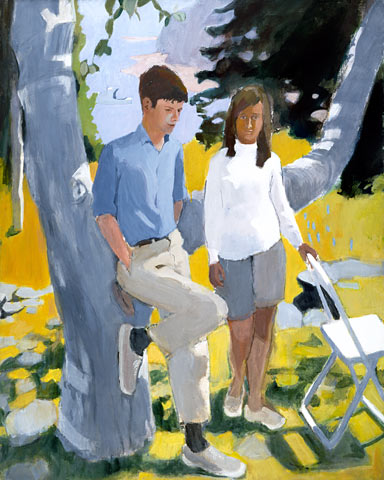
For, the more one looks at them, the less the paintings seem celebrations of atmosphere and moments but, rather, strong, contentious, and thorny. He painted his surroundings as they looked, and they happened to look cozy. But the coziness is deceiving. The local color is transparent and porous, letting the dark light of space show through. The painting has the vehemence of abstraction, though it speaks another language.
In the same letter Porter quoted from memory a line of Wittgenstein that he felt central to his own view of aesthetics: "Every sentence is in order as it is." And he went on astonishingly to elaborate: "Order seems to come from searching for disorder, and awkwardness from searching for harmony or likeness, or the following of a system. The truest order is what you already find there, or that will be given if you don't try for it. When you arrange, you fail." I think it is in the light of statements like these that we must now look at Porter's painting, prepared to find the order that is already there, not the one that should be but the one that is.
(1982)
